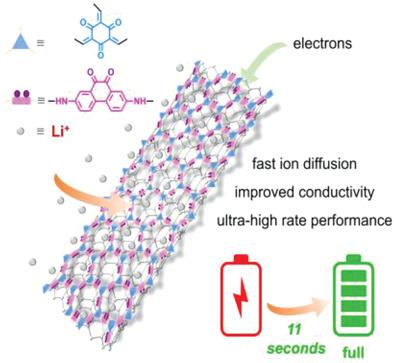当前位置:
X-MOL 学术
›
Adv. Energy Mater.
›
论文详情
Our official English website, www.x-mol.net, welcomes your
feedback! (Note: you will need to create a separate account there.)
Integrated Covalent Organic Framework/Carbon Nanotube Composite as Li-Ion Positive Electrode with Ultra-High Rate Performance
Advanced Energy Materials ( IF 24.4 ) Pub Date : 2021-09-12 , DOI: 10.1002/aenm.202101880 Hui Gao 1, 2 , Qiang Zhu 1 , Alex R. Neale 2 , Mounib Bahri 3 , Xue Wang 1, 4 , Haofan Yang 1, 4 , Lunjie Liu 1 , Rob Clowes 1 , Nigel D. Browning 3 , Reiner Sebastian Sprick 5 , Marc A. Little 1 , Laurence J. Hardwick 2 , Andrew I. Cooper 1, 6
Advanced Energy Materials ( IF 24.4 ) Pub Date : 2021-09-12 , DOI: 10.1002/aenm.202101880 Hui Gao 1, 2 , Qiang Zhu 1 , Alex R. Neale 2 , Mounib Bahri 3 , Xue Wang 1, 4 , Haofan Yang 1, 4 , Lunjie Liu 1 , Rob Clowes 1 , Nigel D. Browning 3 , Reiner Sebastian Sprick 5 , Marc A. Little 1 , Laurence J. Hardwick 2 , Andrew I. Cooper 1, 6
Affiliation

|
Covalent organic frameworks (COFs) are promising electrode materials for Li-ion batteries. However, the utilization of redox-active sites embedded within COFs is often limited by the low intrinsic conductivities of bulk-grown material, resulting in poor electrochemical performance. Here, a general strategy is developed to improve the energy storage capability of COF-based electrodes by integrating COFs with carbon nanotubes (CNT). These COF composites feature an abundance of redox-active 2,7-diamino-9,10-phenanthrenequinone (DAPQ) based motifs, robust β‑ketoenamine linkages, and well-defined mesopores. The composite materials (DAPQ-COFX—where X = wt% of CNT) are prepared by in situ polycondensation and have tube-type core-shell structures with intimately grown COF layers on the CNT surface. This synergistic structural design enables superior electrochemical performance: DAPQ-COF50 shows 95% utilization of redox-active sites, long cycling stability (76% retention after 3000 cycles at 2000 mA g−1), and ultra-high rate capability, with 58% capacity retention at 50 A g−1. This rate translates to charging times of ≈11 s (320 C), implying that DAPQ-COF50 holds excellent promise for high-power cells. Furthermore, the rate capability outperformed all previous reports for carbonyl-containing organic electrodes by an order of magnitude; indeed, this power density and the rapid (dis)charge time are competitive with electrochemical capacitors.
中文翻译:

集成共价有机骨架/碳纳米管复合材料作为具有超高倍率性能的锂离子正极
共价有机骨架(COFs)是锂离子电池有前景的电极材料。然而,嵌入在 COF 中的氧化还原活性位点的利用通常受到块状生长材料的低本征电导率的限制,导致电化学性能不佳。在这里,开发了一种通用策略,通过将 COF 与碳纳米管 (CNT) 集成来提高基于 COF 的电极的能量存储能力。这些 COF 复合材料具有丰富的基于氧化还原活性的 2,7-二氨基-9,10-菲醌 (DAPQ) 基序、强大的 β-酮烯胺键和明确定义的介孔。复合材料(DAPQ-COFX——其中X = wt% CNT) 是通过原位缩聚制备的,具有管型核壳结构,在 CNT 表面上有紧密生长的 COF 层。这种协同结构设计可实现卓越的电化学性能:DAPQ-COF50 显示 95% 的氧化还原活性位点利用率、长循环稳定性(2000 mA g -1 3000 次循环后保留 76% )和超高倍率能力,58% 50 A g -1 时的容量保持率. 该速率转化为 ≈11 s (320 C) 的充电时间,这意味着 DAPQ-COF50 对高功率电池具有极好的前景。此外,对于含羰基的有机电极,倍率性能优于之前所有报告的一个数量级。事实上,这种功率密度和快速(放电)充电时间可与电化学电容器相媲美。
更新日期:2021-10-21
中文翻译:

集成共价有机骨架/碳纳米管复合材料作为具有超高倍率性能的锂离子正极
共价有机骨架(COFs)是锂离子电池有前景的电极材料。然而,嵌入在 COF 中的氧化还原活性位点的利用通常受到块状生长材料的低本征电导率的限制,导致电化学性能不佳。在这里,开发了一种通用策略,通过将 COF 与碳纳米管 (CNT) 集成来提高基于 COF 的电极的能量存储能力。这些 COF 复合材料具有丰富的基于氧化还原活性的 2,7-二氨基-9,10-菲醌 (DAPQ) 基序、强大的 β-酮烯胺键和明确定义的介孔。复合材料(DAPQ-COFX——其中X = wt% CNT) 是通过原位缩聚制备的,具有管型核壳结构,在 CNT 表面上有紧密生长的 COF 层。这种协同结构设计可实现卓越的电化学性能:DAPQ-COF50 显示 95% 的氧化还原活性位点利用率、长循环稳定性(2000 mA g -1 3000 次循环后保留 76% )和超高倍率能力,58% 50 A g -1 时的容量保持率. 该速率转化为 ≈11 s (320 C) 的充电时间,这意味着 DAPQ-COF50 对高功率电池具有极好的前景。此外,对于含羰基的有机电极,倍率性能优于之前所有报告的一个数量级。事实上,这种功率密度和快速(放电)充电时间可与电化学电容器相媲美。











































 京公网安备 11010802027423号
京公网安备 11010802027423号